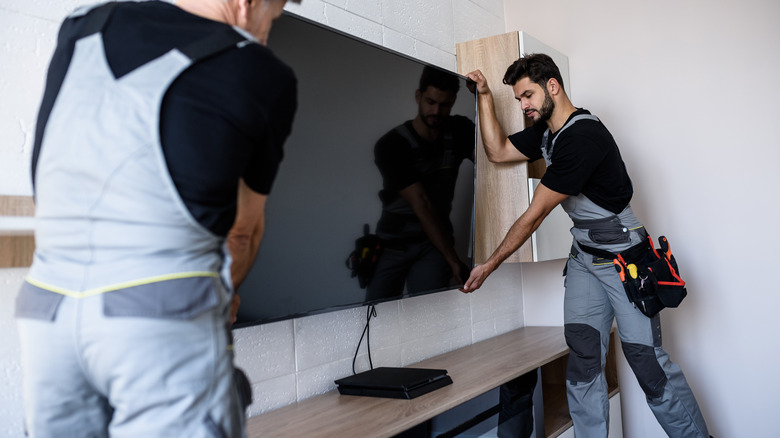How To Decide Where To Mount Your Flat-Screen TV
The television is central to most people's living rooms and bedrooms. Homeowners and renters generally have two options when setting up their TV — placing it on a TV stand or mounting it to the wall. There are definite advantages and disadvantages to both depending on the room itself, your lifestyle, comfortability using power tools, etc.
The benefits of television stands are that they offer more storage and surfaces to decorate, but the downside is that they take up a lot of space and can be dangerous if you have pets and-or children. Sharecare reports that 10,000 children per year get injured from televisions tipping over, 330 of which have resulted in fatalities since 2000. Mounted flat-screen TVs, however, are more secure and don't risk children or pets curiously pushing them over. They also help free up floor space and utilize wall space. The major drawback, though, is that they're not maneuverable — once placed, it's there for the foreseeable future, so you want to make sure you choose the right spot the first time.
Distance
There are a few factors to consider when deciding where to mount your television. One, you need to keep windows, doors, and lights in mind — you don't want a permanent glare on your screen, warns Bassett Furniture. You also want it to be in tune with other furniture. If you're mounting a TV in the bedroom, you'll want to see it from your bed.
The more significant issue, though, is the size of your television. You need to make sure there's enough space for the screen, of course, but the size of your television also impacts how far away it should be. Not only the size but the screen resolution, too, according to Canstar Blue. A general guideline is that HD TVs should be placed 1.5 to 2.5 times the diagonal screen measurement away from you, and for 4K TVs, that measurement is between 1 and 1.5 times.
Height
Aside from height, the other factor you must consider when mounting your flatscreen television to the wall is how high it goes. There isn't a simple ratio for height, but there are recommended options. According to Plank & Pillow, you should go by the actual width of the TV — not the diagonal measurement on the box.
With those dimensions on hand, a TV that is 42 inches in width should be hung 56 inches high, a 55-inch TV 61 inches high, a 65-inch TV 65 inches high, and a 70-inch TV 67 inches high. However, all of these measurements are adjustable based on the needs of each room. So, you may want to hang your television lower in your bedroom if you have a particularly low-sitting couch or a little higher if you plan on using your TV for games or exercise. Once you know the general vicinity, Bassett Furniture recommends playing around with placement before finding studs and installing the mounts. Have a couple of friends hold the TV up in places you're considering, or use a cardboard or paper cutout.


